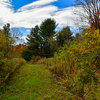New county reg: Helderberg views must be considered
ALBANY COUNTY — The county planning board must now consider the Helderberg escarpment viewshed when making project recommendations to local planning and zoning boards.
That’s because this week the Albany County Legislature unanimously adopted a resolution requiring such consideration.
The legislation stemmed from an issue that arose in Guilderland recently, said Jeff Perlee, the Altamont Republican who spearheaded the bill in the county legislature.
In 2019, a five-megawatt solar array was proposed for a sloping 61-acre field that overlooks Orchard Creek golf course. An organized public outcry led the town to make additions to its original solar law, and eventually the owners of Orchard Creek and their neighbor came to an agreement on the project — the newest proposal was slated for a Guilderland Planning Board site-plan review during its Feb. 10 meeting.
Perlee said that the initial Orchard Creek solar proposal had been referred to the Albany County Planning Board five or six months prior to when residents began focusing on it. The county planning board signed off on the solar proposal.
Digging into the project, Perlee said, he found that, when the county planning board looked at the initial proposal, there were no criteria with which the board could have considered or assessed the impact the proposed solar development would have on the view.
“It was irrelevant to them,” Perlee said of the county planning board, “because it wasn’t in their charge to consider” the visual impact.
The intent of the new legislation is clear, Perlee said, when the county planning board has jurisdiction, as it did in the Orchard Creek proposal, it is now “obliged” to consider the proposed development’s impact on the “critical viewshed.”
In addition to the planning board having to consider a project’s visual impact on the Helderberg escarpment, the new legislation tasks the Albany County Department of Economic Development, Conservation, and Planning with producing a scenic resource assessment of the area’s “primary public roadway corridors” and a viewshed analysis that prioritizes viewsheds within the towns of Guilderland, New Scotland, and Bethlehem.
Recently, in New Scotland and Guilderland, for example, the local boards making the actual decision about whether or not a proposal is approved have discarded county planning board comments cautioning against project approval.
The New Scotland Zoning Board of Appeals, in recently approving a solar project on Altamont Road, went against the county planning board’s recommendation of voting down a needed variance because the applicant’s request didn’t fulfill the balancing test for area variances. The county board also noted New Scotland’s own solar law prohibited the construction of solar-array projects on parcels with prime soil.
In explaining its override vote, New Scotland’s zoning board said the county planning board hadn’t identified any county-wide or inter-municipal impacts that were any different from the factors the zoning board considered in its extensive, months-long review of the application.
In Guilderland last December, the zoning board drew criticism from several residents for its approval of a three-and-a-half-foot height variance that exposed inconsistencies in a recently-revised law.
When a caller to the public hearing pointed out that the county planning board’s recommendation was for the zoning board to “consider the precedent setting nature of allowing significant area variances to the building height,” she was told that the county planning board makes that note on every comment it gives to the board.
Asked about the new legislation and how, or if, it will change the way local boards deal with county planning board recommendations, Perlee pointed out that a county recommendation is more than just a recommendation. If the county board makes a negative recommendation about a proposal, Perlee said, it would force the local board to approve a proposal by a supermajority vote.
By state law, five of seven Guilderland Planning Board members would have to vote in favor of a proposal — or four out of five zoning board members. The legislation doesn’t give the county final say, Perlee said, but the new law does have “some teeth.”
Perlee said he thought that he and William Reinhardt, a Slingerlands Democrat who worked with Perlee on the bill, were in agreement that the new legislation was a “good step,” and, in light of what happened with the Orchard Creek solar-array proposal at the county planning board, “a necessary step.”
But it’s also “understood to be the first step,” to what the bill’s backers hope is an ongoing and more comprehensive understanding and protection of the Helderberg escarpment, Perlee said.
Reinhardt told The Enterprise that, although the genesis for the legislation, the proposed solar project overlooking Orchard Creek, had resolved itself, he and Perlee began to discuss the issues that were brought up as a result of the Orchard Creek proposal.
“We thought, ‘Well, maybe there is something here that we should try to do to have the county planning function more explicitly to address the issue of viewshed,’” Reinhardt said.
Why is preserving the viewshed important?
Reinhardt said that he and Perlee were in agreement that recreation and tourism are important to the county and its economy, in particular to the districts the two local lawmakers represent in the legislature.
The two men had a shared vision of tourism that could be encouraged through careful consideration of developmental impact, he said, like the promotion of agro-tourism — such as people using the rail trail to bike to Indian Ladder Farms.
But there are also certain types of development that can hinder tourism, Reinhardt said, stressing the new law is neither anti-solar nor anti-development, but it does recognize that some types of development can impact tourism through the viewshed issue, and so, as the county continues to plan for future development, the legislators wanted to incorporate a more structured way of viewshed considerations.


